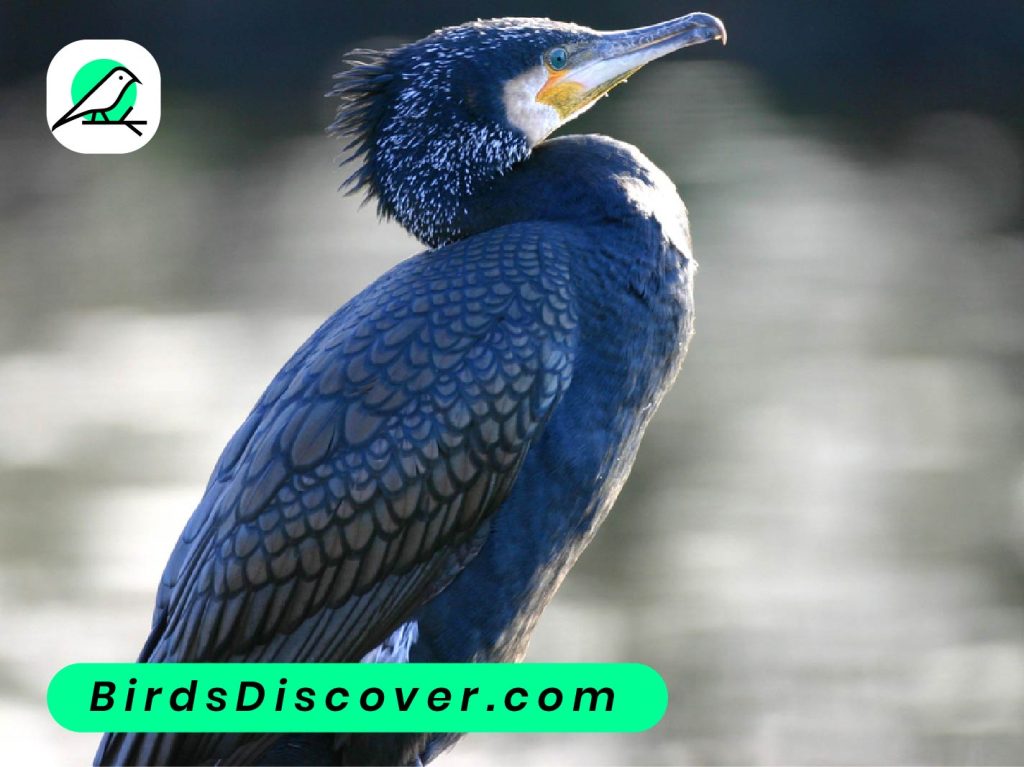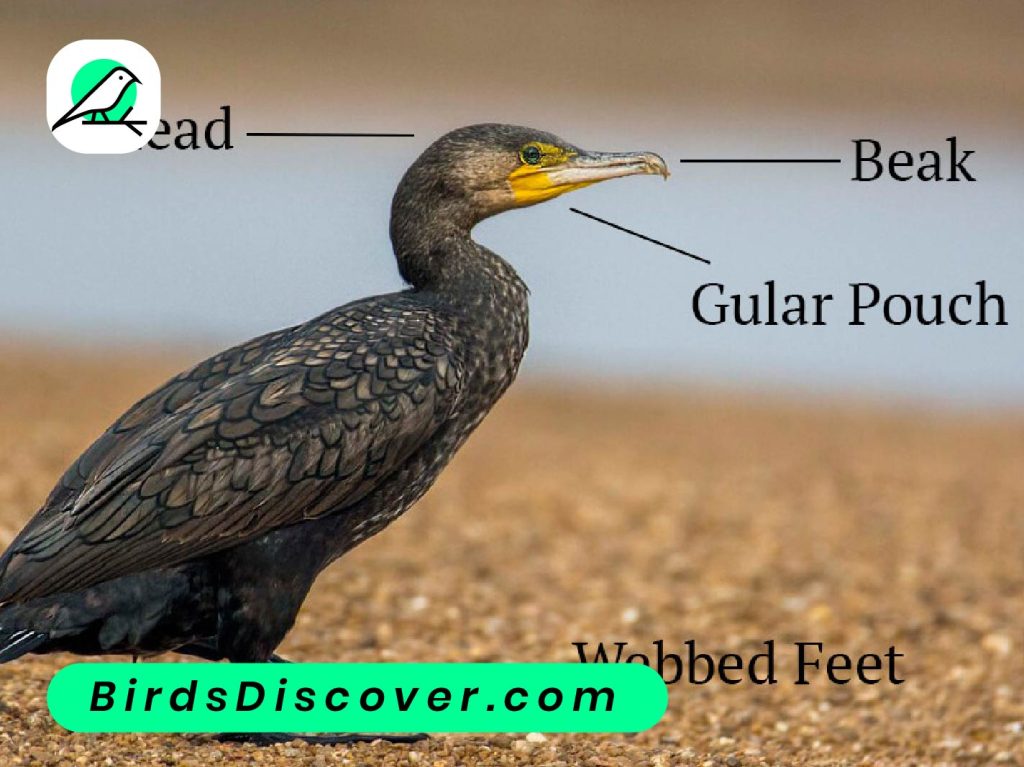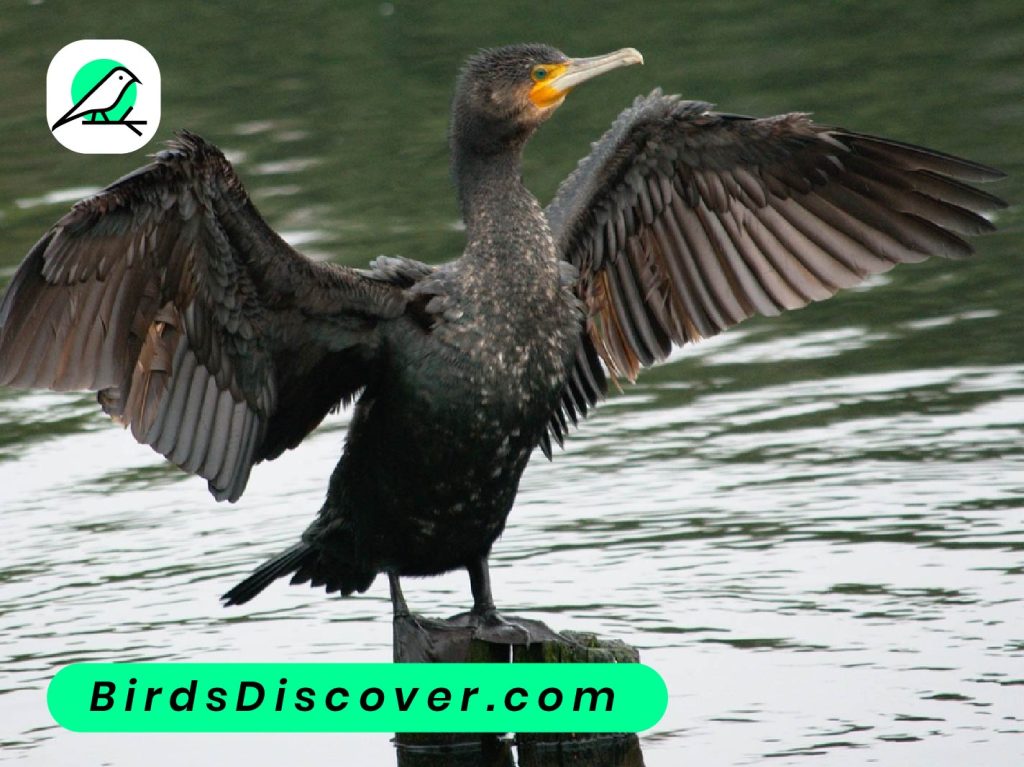Great Cormorant Diet: Habitat, Overview, and More [Phalacrocorax carbo]

They thrive in both freshwater and saltwater environments, often seen perched on rocks or trees near water.
These birds are skilled divers and play a vital role in aquatic ecosystems as top predators.
Great Cormorant
Great Cormorant (*Phalacrocorax carbo*) is a versatile and widely distributed bird found in diverse aquatic environments across Europe, Asia, Africa, and parts of Australia. Characterized by its sleek black plumage and long neck, this large cormorant is a proficient swimmer and diver, specializing in catching fish with its sharp beak. Great Cormorants are commonly seen perched with their wings spread to dry, as their feathers are not fully waterproof. They nest in large colonies on trees or cliff ledges, and their distinctive calls are used for communication. Although they face challenges such as habitat loss and pollution, Great Cormorants remain abundant and adaptable, thriving in a variety of habitats.
Scientific Classification
| Taxonomic Rank | Scientific Classification |
|---|---|
| Kingdom | Animalia |
| Phylum | Chordata |
| Class | Aves |
| Order | Suliformes |
| Family | Phalacrocoracidae |
| Genus | Phalacrocorax |
| Species | Phalacrocorax carbo |
Great Cormorant Sound
The Great Cormorant (Phalacrocorax carbo) produces a variety of vocalizations, which are typically harsh and croaking in nature. Common sounds include deep, guttural “kraak” or “kroak” calls, especially during the breeding season and within nesting colonies. These calls serve various purposes, such as maintaining contact between individuals, establishing territory, and communicating within the flock. The sounds are used to assert dominance and to coordinate with other cormorants in densely populated breeding sites.
Summary
The Great Cormorant (Phalacrocorax carbo) is a versatile and widely distributed bird found in diverse aquatic environments across Europe, Asia, Africa, and parts of Australia. Characterized by its sleek black plumage and long neck, this large cormorant is a proficient swimmer and diver, specializing in catching fish with its sharp beak. Great Cormorants are commonly seen perched with their wings spread to dry, as their feathers are not fully waterproof. They nest in large colonies on trees or cliff ledges, and their distinctive calls are used for communication. Although they face challenges such as habitat loss and pollution, Great Cormorants remain abundant and adaptable, thriving in a variety of habitats.
Taxonomy of Great Cormorant
| Taxonomic Rank | Scientific Classification |
|---|---|
| Kingdom | Animalia |
| Phylum | Chordata |
| Class | Aves |
| Order | Suliformes |
| Family | Phalacrocoracidae |
| Genus | Phalacrocorax |
| Species | Phalacrocorax carbo |

Etymology of Great Cormorant
- Genus Name (Phalacrocorax): Derived from Greek, where “phalakros” means “bald” or “bare” and “korax” means “raven.” This refers to the bird’s bare face and the general appearance of its head, which is reminiscent of a raven.
- Species Name (carbo): Originates from Latin, where “carbo” means “charcoal” or “carbon,” likely referring to the bird’s dark, black plumage.
- Common Name: “Great Cormorant” reflects its large size compared to other cormorant species and its general association with the cormorant family, which includes several species of aquatic birds.
Description
The Great Cormorant (Phalacrocorax carbo) is a striking and robust bird known for its distinctive black plumage and impressive fishing skills. Adults are characterized by their glossy black feathers, which can have a greenish or purplish sheen, and a long, slender neck. Their sharp, hooked beak is adapted for catching fish, their primary diet. The bird has webbed feet, which make it an excellent swimmer, and it uses its powerful legs to dive and propel itself underwater while hunting.
In flight, the Great Cormorant displays its broad wings and long tail, which aid in its maneuverability. It often perches on rocks, trees, or man-made structures with its wings outstretched to dry, as its feathers are not fully waterproof. This behavior is essential because the bird relies on its feathers’ insulation for buoyancy and heat.
Breeding Great Cormorants build large, conspicuous nests in colonies, typically on trees, cliffs, or islands. They lay 3 to 5 eggs, which both parents help to incubate and care for. The chicks are covered in white down feathers when hatched and gradually develop their adult plumage.
Great Cormorants are known for their loud, harsh calls, which are used for communication within their colonies. They are adaptable birds, thriving in a range of habitats from coastal areas and estuaries to inland lakes and rivers. Despite facing threats such as habitat degradation and pollution, they remain abundant and widespread, reflecting their resilience and versatility.
Variations
The Great Cormorant (Phalacrocorax carbo) exhibits several notable variations, primarily distinguished by geographic location and subtle differences in plumage and size. These variations are generally classified into a few subspecies, each adapted to different environments.
- P. c. carbo: The nominate subspecies, found in Europe and parts of Asia, is characterized by its dark, glossy black plumage and large size. This form is often seen in coastal and freshwater habitats across its range.
- P. c. sinensis: Known as the Chinese Cormorant, this subspecies is prevalent in eastern Asia, including China and Japan. It is slightly smaller than the European form and may have a more pronounced white patch on the throat during the breeding season.
- P. c. florealis: Also known as the Indian Cormorant, it inhabits parts of the Indian subcontinent. It is somewhat smaller with a less glossy appearance and often displays subtle differences in bill size and feather structure compared to its European and Chinese counterparts.

These variations reflect the Great Cormorant’s adaptability to diverse habitats, from coastal shores and riverine environments to inland lakes. Each subspecies exhibits slight differences in size, plumage coloration, and breeding behavior, allowing them to thrive in their respective regions.
Distribution
The Great Cormorant (Phalacrocorax carbo) has a broad distribution range, spanning multiple continents and various aquatic environments. It is found across Europe, Asia, and Africa, extending from the British Isles and Scandinavia to South Africa, and from the eastern Mediterranean to Japan and China. In Australia, the species is present along the eastern and southern coasts. It thrives in diverse habitats, including coastal areas, estuaries, lakes, rivers, and reservoirs. The bird’s adaptability allows it to occupy both freshwater and marine environments, making it a versatile and widespread species.
Behaviour
Great Cormorants are highly skilled and efficient hunters, using their strong, webbed feet to dive and swim underwater in search of fish. They can remain submerged for extended periods, reaching depths of up to 15 meters (49 feet) while hunting. After diving, they often perch on rocks, trees, or man-made structures with their wings outstretched to dry, as their feathers are less water-resistant than those of other birds. This drying behavior is crucial for maintaining buoyancy and body temperature. Socially, Great Cormorants can be seen either alone or in groups, with larger aggregations forming during the non-breeding season or in areas with abundant food sources. Their vocalizations, which include harsh, croaking calls, are used for communication, particularly within breeding colonies and during social interactions.
Breeding
Breeding for Great Cormorants typically occurs from spring to summer, depending on their geographical location. They are known for their colonial nesting behavior, often building large nests in trees, on cliffs, or on artificial structures like bridges and towers. Nests are constructed with sticks, seaweed, and other materials, and are usually located in close proximity to water sources to facilitate easy access for hunting. The female lays 3 to 5 eggs, which both parents take turns incubating for about 4 to 5 weeks. After hatching, the chicks are altricial, meaning they are born relatively undeveloped and require extensive care from both parents. They are fed a diet of regurgitated fish by the adults and remain in the nest for approximately 6 to 8 weeks before fledging. During the breeding season, the adults are highly territorial, using vocalizations and displays to defend their nesting sites from other cormorants and potential predators.
Feeding
The Great Cormorant (Phalacrocorax carbo) is a highly efficient predator with a diet primarily consisting of fish. Equipped with a sharp, hooked beak and webbed feet, it is well-adapted for diving and catching prey underwater. The cormorant uses its powerful legs to propel itself and its webbed feet to maneuver through the water, often diving to depths of up to 15 meters (49 feet) in pursuit of fish. It employs a variety of hunting techniques, including pursuing fish by sight and herding schools of fish into shallow waters. After a successful dive, the cormorant returns to the surface to swallow its catch, sometimes needing to adjust the fish to an optimal orientation before swallowing. Because its feathers are less water-resistant than those of some other birds, the Great Cormorant frequently perches with its wings spread to dry after fishing. This drying behavior helps maintain buoyancy and thermal regulation, ensuring that it is ready for the next fishing expedition. The bird’s feeding behavior is critical not only for its survival but also for maintaining its role in aquatic ecosystems, where it helps regulate fish populations.
Species in Same Genus
| Species | Common Name |
|---|---|
| Phalacrocorax carbo | Great Cormorant |
| Phalacrocorax auritus | Double-crested Cormorant |
| Phalacrocorax pelagicus | Pelagic Cormorant |
| Phalacrocorax aristotelis | European Shag |
| Phalacrocorax brasilianus | Neotropic Cormorant |
| Phalacrocorax penicillatus | Brandt’s Cormorant |
| Phalacrocorax capensis | Cape Cormorant |
| Phalacrocorax nigrogularis | Pygmy Cormorant |
| Phalacrocorax sulcirostris | Long-tailed Cormorant |

Relationships with Humans
The Great Cormorant (Phalacrocorax carbo) has had a complex and varied relationship with humans throughout history, reflecting both positive and negative interactions.
Positive Relationships
- Traditional Fishing Practices: In several cultures, particularly in Asia, Great Cormorants have been used in traditional fishing techniques. Fishermen in countries like China, Japan, and Thailand have trained cormorants to catch fish in a practice known as “cormorant fishing.” The birds are trained to dive into the water and catch fish, which they are then compelled to release, allowing fishermen to retrieve the catch. This practice showcases a unique human-animal collaboration that has been a part of these cultures for centuries.
- Ecological Role: Great Cormorants play a crucial role in aquatic ecosystems by helping to control fish populations. Their predation helps maintain a balance in aquatic environments, which can benefit fisheries and support biodiversity. In some areas, their presence is seen as a sign of a healthy, functioning ecosystem.
Negative Relationships
- Conflict with Fisheries: The Great Cormorant is often considered a nuisance by commercial and recreational fishermen because of its substantial fish consumption. Cormorants can deplete fish stocks in lakes, rivers, and reservoirs, leading to conflicts with fishery interests. This has sometimes resulted in culling programs or other management measures aimed at reducing their impact on fish populations.
- Habitat Disruption: The presence of large cormorant colonies can lead to the destruction of vegetation in nesting sites, particularly in coastal or freshwater areas where they establish breeding colonies. This can negatively impact other wildlife and disrupt local ecosystems.
- Cultural and Economic Tensions: In regions where cormorant fishing is no longer practiced or where cormorants are seen as a threat to commercial fish stocks, there can be cultural and economic tensions. This has led to varying levels of protection or control measures for the species, depending on local attitudes and the economic importance of fisheries.
Overall, the relationship between Great Cormorants and humans is multifaceted, involving both cooperative interactions and conflicts. Efforts to manage and conserve the species often need to balance ecological benefits with the practical concerns of human activities.\
Lifespan
In the wild, Great Cormorants generally have a lifespan of about 10 to 15 years. However, this can vary based on environmental conditions, predation, and human impacts. In captivity, where they are protected from natural threats and have access to regular care, they can live up to 20 years or more. The extended lifespan in captivity reflects the absence of many of the dangers they face in the wild, such as predators and food shortages.
Speed
Great Cormorants are capable of flying at speeds of up to 40 to 50 kilometers per hour (25 to 31 miles per hour). Their flight is strong and direct, and they are well-adapted for long-distance travel across their aquatic habitats. While they are not the fastest birds, their speed is sufficient for navigating between feeding grounds and breeding sites, and for escaping from potential threats.
Threats
The Great Cormorant (Phalacrocorax carbo) faces several threats that impact its populations and overall well-being. These threats include:
- Habitat Loss and Degradation: Urban development, deforestation, and agricultural expansion can lead to the destruction and fragmentation of the cormorant’s natural habitats. The loss of nesting sites and feeding grounds, especially in coastal and freshwater areas, can negatively affect their survival and breeding success.
- Pollution: Water pollution from industrial, agricultural, and municipal sources poses a significant threat to Great Cormorants. Contaminants such as heavy metals, pesticides, and other pollutants can poison the birds directly or harm their prey, leading to decreased food availability and health issues.
- Overfishing and Fishery Conflicts: The Great Cormorant’s diet primarily consists of fish, and its foraging can sometimes conflict with commercial and recreational fishing interests. Overfishing can reduce fish stocks, impacting the cormorant’s food supply, while culling programs or management measures aimed at reducing cormorant populations can also pose direct threats.
- Climate Change: Climate change can alter the availability and distribution of the cormorant’s food sources, as well as impact their breeding habitats. Changes in temperature, sea level rise, and shifts in prey populations can affect their overall survival and breeding success.
- Human-Wildlife Conflict: In some regions, Great Cormorants are viewed as pests due to their impact on local fish populations. This can lead to negative human responses, including culling or other control measures, which can directly threaten their numbers.
- Diseases: Like many wildlife species, Great Cormorants are susceptible to diseases that can affect their health and reproductive success. Disease outbreaks can be exacerbated by environmental stressors and pollution.
Addressing these threats requires a combination of habitat conservation, pollution control, sustainable fishery practices, and effective management strategies to ensure the long-term viability of Great Cormorant populations.

Common Names in Different Languages
| Language | Common Name |
|---|---|
| English | Great Cormorant |
| Spanish | Cormorán Grande |
| French | Grand Cormoran |
| German | Kormoran |
| Italian | Cormorano Comune |
| Dutch | Grote Cormorant |
| Portuguese | Cormorão Grande |
| Russian | Большой баклан (Bol’shoy baklan) |
| Chinese | 大鸬鹚 (Dà lúcí) |
| Japanese | カワウ (Kawau) |
| Korean | 큰노랑부리 (Keun norangburi) |
| Thai | นกอ้ายงั่ว (Nok ài ngûa) |
| Hindi | बड़ा कोमोरेंट (Bada komorent) |
FAQS
What is the primary diet of the Great Cormorant?
The Great Cormorant primarily feeds on fish, which constitutes the majority of its diet. It is a skilled hunter, using its sharp beak and strong swimming abilities to catch fish underwater. The bird may also consume small invertebrates and occasionally amphibians.
Where can Great Cormorants be found?
Great Cormorants have a wide distribution and are found across Europe, Asia, Africa, and parts of Australia. They inhabit various aquatic environments, including coastal areas, estuaries, lakes, rivers, and reservoirs. They are adaptable birds that can thrive in both freshwater and marine habitats.
How do Great Cormorants catch their food?
Great Cormorants are adept divers and use their webbed feet to propel themselves underwater while hunting. They can dive to depths of up to 15 meters (49 feet) to pursue fish, often using their sharp beak to capture prey. After diving, they return to the surface to swallow their catch.
What are the main threats to Great Cormorants?
The main threats to Great Cormorants include habitat loss and degradation, pollution, conflicts with fisheries, climate change, and diseases. Human activities, such as urban development and pollution, can negatively impact their habitats, while conflicts with fishing interests can lead to culling or other management measures.
How do Great Cormorants breed?
Great Cormorants breed in colonies, often building large nests in trees, on cliffs, or on artificial structures like bridges. The female lays 3 to 5 eggs, which both parents incubate for about 4 to 5 weeks. After hatching, the chicks are altricial and remain in the nest, being fed by the parents until they fledge approximately 6 to 8 weeks later.







